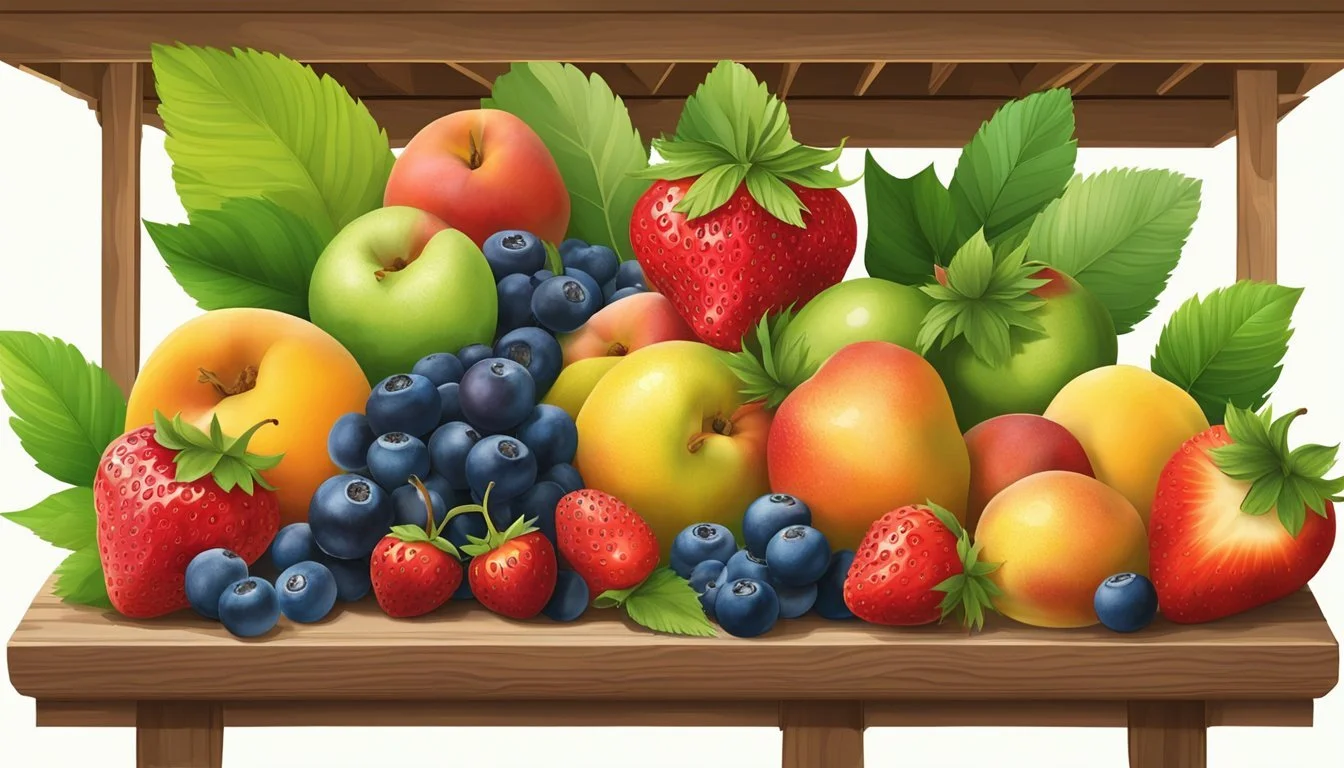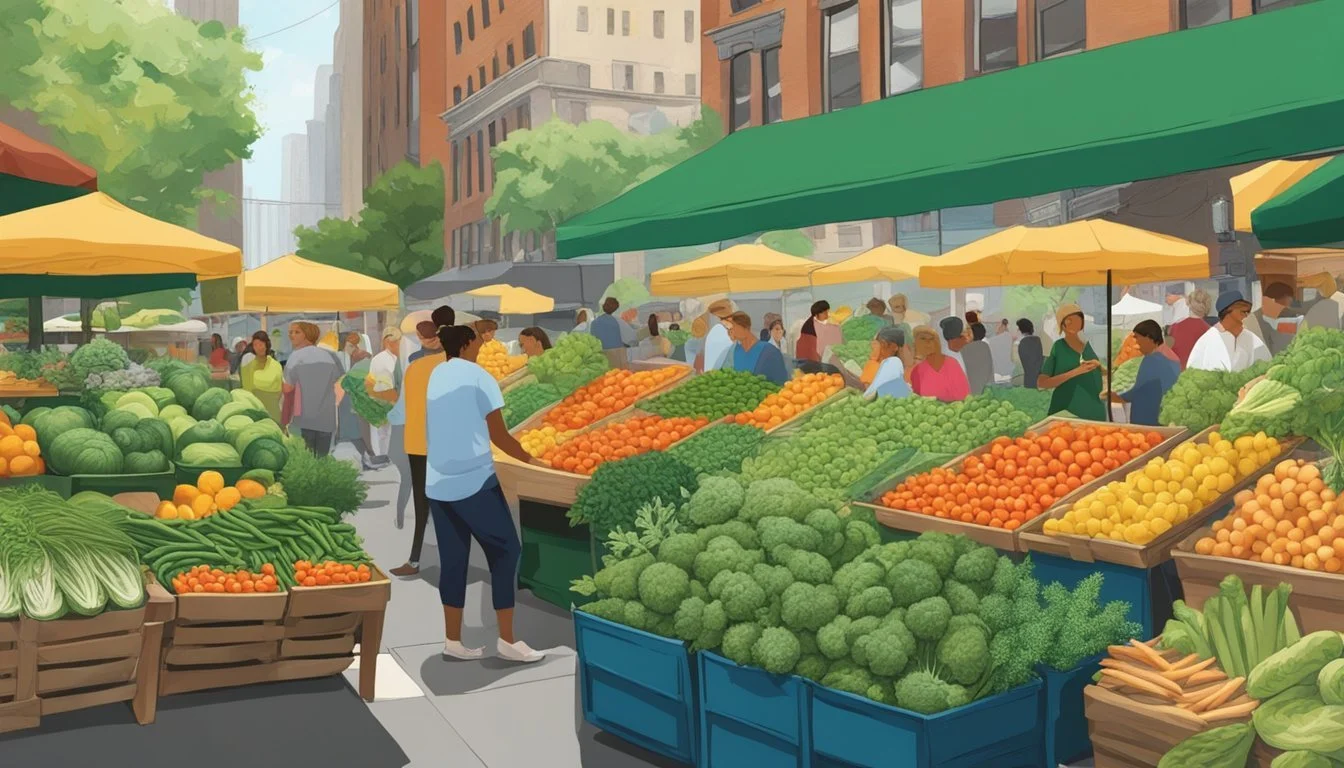New York Seasonal Fruit & Vegetables in July
Your Guide to Fresh Produce
This Article is Part of our New York Seasonal Fruit & Veg Calendar
July in New York marks a period of abundance when it comes to fresh produce. The summer season reaches its peak, bringing a generous variety of fruits and vegetables to the tables of local homes and restaurants. During this month, farmers' markets and grocery store aisles become more colorful with the influx of seasonal offerings. New Yorkers enjoy a selection of ripe fruits and fresh vegetables that are not only at their flavor prime but also offer a snapshot of the region's agricultural richness.
The warm July weather fosters the growth of several fruits, including blueberries (how long do blueberries last?), which are a notable treat during this time. Berries harvested in this month are known for their optimal sweetness and are a hallmark of summer desserts in New York. Similarly, cantaloupes (how long does cantaloupe last?) make a sweet, hydrating appearance, providing a refreshing option during the summer heat.
New York's vegetable offerings are equally impressive in July, with a variety of leafy greens and hearty vegetables reaching maturation. Broccoli and cauliflower emerge, offering versatility for both raw and cooked dishes, while carrots add crunch and color to midsummer meals. From salads to grilled sides, the vegetables harvested during this time are integral to the culinary landscape, reflecting the seasonal bounty of the state.
Seasonal Highlights
July in New York showcases a bounty of ripe fruits and vegetables, marking the apex of summer's vibrant harvest season.
Top Summer Produce
Fruits:
Berries: Strawberries, Blueberries, Raspberries are at their sweetest peak.
Stone Fruits: Cherries, Peaches, and Apricots - fully ripened and ready for consumption.
Melons: Cantaloupes and Watermelons become available, offering refreshing hydration.
Vegetables:
Leafy Greens: Kale and Spinach thrive in the early part of the month.
Summer Squash: Zucchini and Yellow Squash are plentiful.
Tomatoes: These are beginning to reach their best, with heirloom varieties abound.
Benefits of Eating Seasonal
Eating fruits and vegetables in their season ensures peak flavor, nutritional value, and often, a lower cost due to the abundance. The body receives a variety of nutrients when one eats with the seasons, as the produce is fresher and has traveled shorter distances to the consumer, thus retaining more of its original nutritional content.
Fruit Selection in July
July in New York is a vibrant month for fresh fruit selections, offering a bounty of berry varieties, a range of stone fruit options, and a refreshing assortment of melons.
Berry Varieties
Strawberries: While the strawberry season is winding down, there are still late varieties being harvested.
Blueberries: In full swing in July, these berries are ripe for picking and are a popular choice for both fresh consumption and preserves.
Raspberries: Known for their delicate structure and intense flavor, raspberries reach their peak this month.
Stone Fruits
Peaches: Succulent peaches are a hallmark of July's harvest, with their juicy flesh and sweet aroma filling the market stalls.
Nectarines: Similar to peaches but with a smooth skin, nectarines offer a slightly firmer texture and are also abundantly available.
Melons
Watermelons: Synonymous with summer, watermelons are at their juiciest in July, often characterized by their deep red flesh and sweet taste.
Cantaloupes: These fragrant melons are yielding their musky sweetness this month, perfect for a refreshing snack or a summer salad addition.
Vegetable Harvest
July marks the peak of summer and with it comes a bounty of fresh vegetables in New York. During this month, farmers’ markets and gardens are abundant with a variety of produce, ranging from leafy greens to hearty root crops and succulent summer squashes.
Leafy Greens
Kale: A hearty green that remains a popular choice, known for its nutritional value and versatility in dishes.
Lettuce: Continues to thrive in the summer heat, with varieties such as romaine and leaf lettuce being common.
Chard: Offers bright color to any dish and adds nutritional value similar to other leafy greens available this season.
Root Crops
Beets: These earthy root vegetables are ideal for roasting or adding to salads.
Carrots: Known for their sweet flavor when harvested at the peak of summer; they are perfect for a variety of dishes from raw snacks to intricate meals.
Summer Squash and Cucurbits
Zucchini: A summer favorite, zucchini is versatile for grilling, baking, or spiralizing.
Cucumber: Refreshing and crisp, cucumbers are often eaten fresh or used in salads and pickles.
Eggplant (What wine goes well with eggplant?): With its rich, spongy texture, eggplant is excellent for grilling or as a meat substitute in many recipes.
Tomatoes: Heirloom and cherry tomatoes are bursting with flavor, commonly used in salads, sandwiches, or as a fresh sauce.
Corn: Sweet and tender, corn is a staple of summer barbecues, equally delicious boiled, grilled, or roasted.
Peppers: Both sweet and hot varieties are available, adding a pop of color and flavor to any dish.
Squash: Summer varieties like yellow crookneck offer a buttery flavor, complementing both sweet and savory dishes.
Herbs and More
July in New York State is a flourishing time for a variety of herbs and alliums. Gardeners and local farms offer an abundance of fresh, flavorful choices suitable for culinary uses.
Aromatic Herbs
Basil thrives during the warm summer months, offering its sweet and peppery flavor to dishes. One can find it in abundance at local farmers' markets, often sold in fresh bunches. Thyme, with its earthy and lemony notes, also peaks in July, as does Mint—a versatile herb used in both sweet and savory preparations as well as refreshing beverages. Parsley, another summer herb, comes mostly in two varieties: the curly-leaved and the Italian flat-leaf, both adding a bright, clean taste to meals.
Alliums and Others
Alliums, the family of plants that includes garlic, onions, and scallions, are also widely available in July. Garlic bulbs are harvested in July, and consumers can find fresh garlic that is more mellow and less pungent than the cured cloves (how long do cloves last?) available later in the year. On the other hand, onions arrive at markets in a range of varieties, from sweet to sharp. Scallions, known for their mild onion flavor, are tender and perfect for raw applications, such as garnishes and salads.
Harvesting and Storage Tips
Harvesting and storage methods are crucial for maintaining the quality of produce. They ensure New York's in-season fruits and vegetables reach consumers in the best condition.
Proper Picking
Timing is essential when harvesting produce. Farmers typically pick fruits like berries and cherries early in the morning to avoid the heat of the day, which can stress the plants and negatively impact the quality of the fruit. Vegetables such as lettuce and greens are also harvested in the cooler hours to preserve their crispness and prevent wilting.
Berries: Gently pull ripe berries from the stem; they should come off easily if they're ready.
Greens: Cut the outer leaves and allow the center to continue growing for a prolonged yield.
Storage Practices
After harvesting, immediate cooling is critical to extend the freshness of the produce. Fruits and vegetables like berries, leafy greens, and root crops should be stored in a refrigerator or a cool environment as soon as possible. Here's a basic guide for storing some of New York's July produce:
Berries: Store in a single layer and refrigerate; avoid washing until just before use to prevent mold.
Leafy Greens: Keep in a plastic bag in the crisper drawer of the refrigerator.
Dry storage works for items like onions and garlic, which should be kept in a well-ventilated area away from direct sunlight. Potatoes, typically harvested in July, should also be stored in a cool, dark place to prevent sprouting.
Local Farming Practices
In New York, July marks a season of abundance on farms across the state, showcasing a commitment to agricultural practices that emphasize sustainability and community engagement.
Sustainable Agriculture
In an effort to maintain balance with the natural environment, New York farms implement a range of sustainable practices during the growing season. Crop rotation and integrated pest management are two key techniques. Crop rotation helps in preserving soil health and reducing pests, while integrated pest management minimizes chemical use, instead relying on a combination of biological, cultural, and mechanical controls to manage crop damages.
Cover cropping: Often used to prevent soil erosion and replenish soil nutrients.
Organic farming: Many farms are certified organic, avoiding synthetic fertilizers and pesticides.
Water conservation: Techniques such as drip irrigation are employed to use water efficiently.
Community Supported Agriculture
Community Supported Agriculture (CSA) programs are a cornerstone of the New York local food movement, especially in July when farms are at peak production. CSA members purchase a share of the harvest upfront, and in return, they receive a weekly supply of fresh, locally grown produce. This model not only supports farms financially at the start of the growing season but also fosters direct relationships between farmers and consumers.
Local engagement: CSAs often encourage pick-ups directly from the farm, which can include events and volunteering opportunities.
Diversity of produce: CSA shares typically feature a variety of what's in season, providing an incentive for eating local and trying new fruits and vegetables.
Monthly Produce Guide
In July, New York's markets brim with a variety of fresh produce. Shoppers can find an abundance of fruits and vegetables at peak ripeness during this midsummer month.
Preceding Month Overview
In June, just before July's bounty, shoppers typically find the last of the springtime favorites like strawberries and asparagus (how long does asparagus last?). These earlier harvests pave the way for the heartier summer selections. Residents anticipate the transition into July when even more fruits and vegetables reach their optimal flavor and availability.
Fruits commonly available in June:
Cherries
Blueberries (late June)
Vegetables commonly available in June:
Asparagus
Green beans
Peas
Following Month Preview
As August approaches, one can expect a continued abundance of summer produce with some late-season fruits and vegetables starting to appear. August introduces a new range of produce like early apples and late-summer squashes, continuing the cycle of fresh, local produce options.
Fruits to look forward to in August:
Apples (early varieties)
Peaches
Blueberries
Vegetables to look forward to in August:
Corn
Tomatoes
Summer squash









